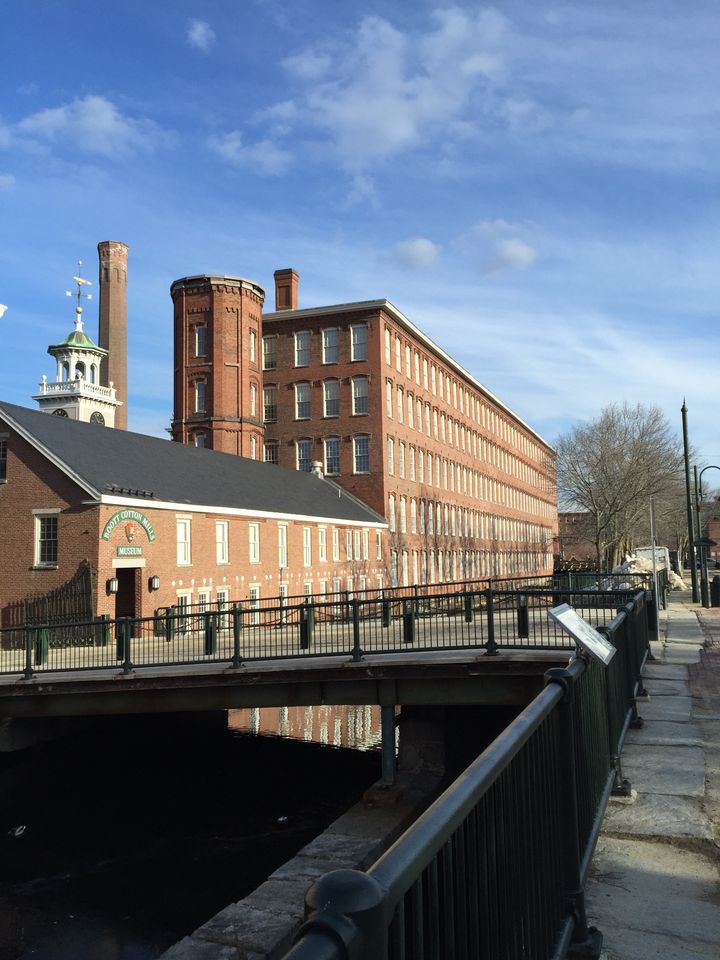
Lowell’s 1835 Boott Mill, which houses the Tsongas Industrial History Center
Every year, more than 500,000 people visit the Lowell National Historical Park in Lowell, Massachusetts, where the city’s water power helped fuel the American Industrial Revolution. Created in 1978, Lowell National Historical Park is celebrating its 39th anniversary this week. In addition to telling the story of Lowell’s industrial heritage, the park has also helped spark the revitalization of over 450 buildings and 98 percent of the city’s 5.2 million square feet of mill space.
Today, Lowell’s half-million visitors contribute approximately $48 million annually to the local economy. In addition, about 50,000 of Lowell’s annual visitors are primary school students and teachers, who actively experience 19th century technology, politics, and social life through experimentation, building, weaving, role-playing, and educational canal tours. Throughout Lowell, the park employs lock workers, trolley drivers, U.S. Coast Guard-certified boat captains, rangers who provide historic interpretation, and countless other workers.
Unfortunately, like countless other National Park Service sites, Lowell National Historical Park suffers from severe budget and maintenance difficulties. Lowell is currently facing an estimated $12.1 million deferred maintenance burden that impacts its collection of historic buildings, walkways, canal gatehouses, and other infrastructure components across its 137 acres. If we can better support the National Park Service, we will help Lowell and hundreds of other sites tackle their backlogs and conduct ongoing maintenance. We would create a richer experience for park visitors and locals, increasing economic prosperity and cultural vitality in legions of places like Lowell.
History of Lowell National Historical Park
In the second half of the 19th century, the city of Lowell helped spark the Industrial Revolution in the United States. Entrepreneur and city namesake Francis Cabot Lowell led efforts to use earlier canals to power his company’s textile looms. By using the canal for energy, this company was able to house its entire textile production under one roof, a major step forward for America’s fledgling textile industry. Also, due to Lowell’s need for American-made machinery, the United States gained some of its earliest master mechanics, which helped support other commercial industries. Further, the city’ labor demands first encouraged women and, later, immigrants to leave their farms and homelands. By 1850, Lowell boasted six miles of canals that powered over 10,000 textile looms in 40 buildings.
By the end of World War II, Lowell lost its manufacturing foothold and struggled to find a new economic niche. Soon after, state, local, and federal partners rallied to make Lowell one of the country’s first urban national parks. In 1978, the late Massachusetts Senator Paul Tsongas introduced legislation to create Lowell National Historical Park, revitalizing the city and creating the first national park to focus on industrial history.
The Solution
The deferred maintenance challenge at Lowell National Historical Park is indicative of a broader problem. The National Park Service oversees 413 natural, historic, and cultural places in every corner of the U.S. and most of its territories, and the Park Service faces significant challenges to adequately maintain these places. After decades of under-funding, the National Park Service’s total infrastructure repair backlog is estimated at $12 billion (FY 2015), including $3 billion attributed to historic, non-transportation structures and sites.
New, bipartisan legislation has been introduced in both houses of Congress that would address this problem by creating a dedicated federal funding stream for national park maintenance. The National Park Service Legacy Act would dedicate time and investments to repairing NPS’s roads, facilities, and park structures.
Our parks must remain open and accessible, so the public can continue to learn from and experience these places that tell our nation’s history. Our National Park System celebrates our historic and natural treasures, and it is our responsibility to ensure our parks are maintained and preserved so future generations can continue to enjoy and learn from them.
These Senators and Representatives, Democrats and Republicans, have found a way to save our park system, and we urge all of Congress to join this coalition and pass this must-needed legislation. Through this bill, we all can ensure that our distinctive history remains an important and viable part of our future.
